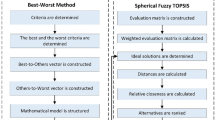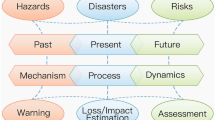Abstract
Predicting or deducing war outcomes is the basis of military strategy formulation. Considering the high information uncertainty and complex influencing factors of modern wars, we applied a fuzzy influence diagram (FID) to realize the macroscopic prediction of war outcomes. In particular, we identified multidimensional factors that influence war outcomes in a relatively comprehensive and practical manner, thereby obtaining a relatively complete FID containing 24 nodes, with the value node “combat outcome” as the core. Subsequently, we performed a simulation analysis for a hypothetical war scenario to demonstrate the specific application and applicability of the proposed FID model. This study expands the prediction methods of war outcomes, and demonstrates that an FID can be feasibly applied in an uncertain battlefield environment to realize the prediction and risk assessment of war outcomes. Moreover, this approach can be used to analyze prewar decision making. The findings highlight that combat participants should attempt to further improve their military technology and combat effectiveness to gain combat advantage.




Similar content being viewed by others
References
Boukhtouta, A., Jentsch, P.: Support vector machine for demand forecasting of canadian armed forces spare parts. In: 2018 6th International Symposium on Computational and Business Intelligence, pp. 59–64 (2018)
Kim, J., Lee, H., Choi, S.: Machine learning based approach for demand forecasting anti-aircraft missiles. In: 2018 5th International Conference on Industrial Engineering and Applications, pp. 367–372 (2018)
Xia, P.C., Chen, M., Zou, J., Feng, X.: Prediction of air target intention utilizing incomplete information. In: Proceedings of 2016 Chinese Intelligent Systems Conference, vol. I, pp. 404, 395–403 (2016)
Huang, R., Liu, X.F., Zheng, X.: Research on performance quality prediction method of missile based on grey theory and SVM. In: Proceedings of the 2018 3rd International Conference on Modelling, Simulation and Applied Mathematics, vol. 160, pp. 140–145 (2018)
Rasmi, M., Jantan, A.: Attack intention analysis model for network forensics. In: 2nd International Conference on Software Engineering and Computing Systems, vol. 180, pp. 403–411 (2011)
Auten, J.R., Hammell, R.J.: Predicting terminal ballistics using an iterative application of an artificial neural network. In: 2017 Computing Conference, pp. 706–715 (2017)
Chen, Y.W., Lee, Y.L., Kung, C.C.: Application of particle swarm optimization based on neural network for artillery range prediction. Control Eng. Appl. Inform. 16(4), 73–80 (2014)
Lagazio, M., Marwala, T.: Assessing different Bayesian neural network models for militarized interstate dispute. Soc. Sci. Comput. Rev. 24(1), 119–131 (2006)
Bidyuk, P., Gozhyj, A., Kalinina, I.: Modeling military conflicts using bayesian networks. In: 2018 Ieee First International Conference on System Analysis & Intelligent Computing, pp. 155–160 (2018)
Yu, Y.T., Ding, Y.: Improved dynamic Bayesian networks in sea-battlefield situation assessment. Adv. Mater. Res. 936, 2149–2154 (2014)
Wiper, M.P., Pettit, L.I., Young, K.: Bayesian inference for a Lanchester type combat model. Naval Res. Logist. 47(7), 541–558 (2015)
Koyuncu, B., Bostanci, E.: Using Lanchester combat models to aid battlefield visualization. In: 2nd IEEE International Conference on Computer Science and Information Technology, pp. 290–292 (2009)
Chen, P.S., Chu, P.: Applying Lanchester’s linear law to model the Ardennes campaign. Naval Res. Logist. 48(8), 653–661 (2001)
Lucas, T.W., Dinges, J.A.: The effect of battle circumstances on fitting Lanchester equations to the Battle of Kursk. Mil. Oper. Res. 9(2), 17–30 (2004)
Lucas, T.W., Turkes, T.: Fitting Lanchester equations to the battles of Kursk and Ardennes. Naval Res. Logist. 51(1), 95–116 (2004)
Kress, M., Caulkins, J.P., Feichtinger, G., Grass, D., Seidl, A.: Lanchester model for three-way combat. Eur. J. Oper. Res. 264(1), 46–54 (2018)
Jiang, Y.L., Liang, Z.Z., Gao, H., Guo, Y., Zhong, Z.M., Yang, C., Liu, J.X.: An improved constraint-based Bayesian network learning method using Gaussian kernel probability density estimator. Expert Syst. Appl. 113, 544–554 (2018)
Zhang, Z., Zhou, Q., Wu, C., Li, H.Y.: Dissipativity-based reliable interval type-2 fuzzy filter design for uncertain nonlinear systems. Int. J. Fuzzy Syst. 20(2), 390–402 (2018)
Chen, S.M., Chiou, C.H.: Multiattribute decision making based on interval-valued intuitionistic fuzzy sets, PSO techniques, and evidential reasoning methodology. Trans. Fuzzy Syst. 23(6), 1905–1916 (2015)
Wang, L.Y., Guo, Z.X., Zhang, Y.F., Shang, Y.S., Zhang, L.: An emergency supplies demand prediction model based on intuitionistic fuzzy case reasoning. J. China Univ. Min. Technol. 44(4), 775–780 (2015)
Li, R.M., Huang, Y.F., Wang, J.: Long-term traffic volume prediction based on type-2 fuzzy sets with confidence interval method. Int. J. Fuzzy Syst. 21(7), 2120–2131 (2019)
Liu, P.D., Zhu, B.Y., Wang, P.: A multi-attribute decision-making approach based on spherical fuzzy sets for Yunnan Baiyao’s R&D project selection problem. Int. J. Fuzzy Syst. 21(7), 2168–2191 (2019)
Liang, R., Wang, J.Q.: A linguistic intuitionistic cloud decision support model with sentiment analysis for product selection in E-commerce. Int. J. Fuzzy Syst. 21(3), 963–977 (2019)
Iakovidis, D.K., Papageorgiou, E.: Intuitionistic fuzzy cognitive maps for medical decision making. IEEE Trans. Inf Technol. Biomed. 15(1), 100–107 (2011)
Hamedan, F., Orooji, A., Sanadgol, H., Sheikhtaheri, A.: Clinical decision support system to predict chronic kidney disease: a fuzzy expert system approach. Int. J. Med. Inform. 138, 1–9 (2020)
Cordero, P., Enciso, M., Lopez, D., Mora, A.: A conversational recommender system for diagnosis using fuzzy rules. Expert Syst. Appl. 154, 1–12 (2020)
Jensen, F.V., Nielsen, T.D., Shenoy, P.P.: Sequential influence diagrams: a unified asymmetry framework. Int. J. Approx. Reason. 42(1), 101–118 (2006)
Howard, R.A., Matheson, J.E.: Influence diagrams. Decis. Anal. 2(3), 127–143 (2005)
Jensen, F.V., Vomlelova, M.: Unconstrained influence diagrams. In: Proceedings of the Eighteenth Conference on Uncertainty in Artificial Intelligence, pp. 234–241 (2002)
Zheng, H.Y., Deng, Y., Hu, Y.: Fuzzy evidential influence diagram and its evaluation algorithm. Knowl. Based Syst. 131, 28–45 (2017)
Lin, Y.H., Lin, C.C., Tyan, Y.Y.: An integrated quantitative risk analysis method for major construction accidents using fuzzy concepts and influence diagram. J. Mar. Sci. Technol. 19(4), 383–391 (2011)
Zhang, Z., Demsar, U., Wang, S.W., Virrantaus, K.: A spatial fuzzy influence diagram for modelling spatial objects’ dependencies: a case study on tree-related electric outages. Int. J. Geogr. Inf. Sci. 32(2), 349–366 (2017)
Kao, H.Y.: Diagnostic reasoning and medical decision-making with fuzzy influence diagrams. Comput. Methods Progr. Biomed. 90(1), 9–16 (2008)
Rodríguez-Muñiz, L.J., López-Dıaz, M., Gil, M.Á.: Solving influence diagrams with fuzzy chance and value nodes. Eur. J. Oper. Res. 167(2), 444–460 (2005)
Shan, J., Liu, Q.: Analysis of the impact of battlefield environment on military operation effectiveness using fuzzy influence diagram. Int. J. Fuzzy Syst. 21(6), 1882–1893 (2019)
Rotte, R., Schmidt, C.M.: On the production of victory: empirical determinants of battlefield success in modern war. Def. Peace Econ. 14(3), 175–192 (2003)
Brathwaite, K.J.H., Konaev, M.: War in the city: urban ethnic geography and combat effectiveness. J. Strateg. Stud. (2019). https://doi.org/10.1080/01402390.2019.1672159
Kim, D., Moon, H., Park, D., Shin, H.: An efficient approximate solution for stochastic Lanchester models. J. Oper. Res. Soc. 68(11), 1470–1481 (2017)
Varghese, V., Desai, S.S., Nene, M.J.: Decision making in the battlefield-of-things. Wirel. Pers. Commun. 106(2), 423–438 (2019)
Dong, J., Wu, G.W., Yang, T.T., Jiang, Z.: Battlefield situation awareness and networking based on agent distributed computing. Phys. Commun. 33, 178–186 (2019)
Rajaraman, R.: Battlefield weapons and missile defense: worrisome developments in nuclear South Asia. Bull. At. Sci. 70(2), 68–74 (2014)
Goztepe, K.: Designing a battlefield fire support system using adaptive neuro-fuzzy inference system based model. Def. Sci. J. 63(5), 497–501 (2013)
Gue, K.R.: A dynamic distribution model for combat logistics. Comput. Oper. Res. 30(3), 367–381 (2003)
Aslan, M., Isik, H.: Green energy for the battlefield. Int. J. Green Energy 14(12), 1020–1026 (2017)
Knudson, G.B., Elliott, T.B., Brook, I., et al.: Nuclear, biological, and chemical combined injuries and countermeasures on the battlefield. Mil. Med. 167(2), 95–97 (2002)
Fu, Q., Jiang, H.L., Wang, X.M., Jing, W.B., Liu, X.Y.: The atmospheric environment simulation of virtual battlefield based on mat module. In: Icms2010: Proceedings of the Third International Conference on Modelling and Simulation, Vol 4: Modelling and Simulation in Biology, Ecology & Environment, pp. 309–313 (2010)
Lin, K., Xia, F.Z., Li, C.S., Wang, D., Humar, I.: Emotion-aware system design for the battlefield environment. Inf. Fusion. 47, 102–110 (2019)
Nallisivan, M., Fyfe, A., Rodriguez, A.R.: Soft power building and China’s peaceful development. China Int. Stud. 4(4), 164–179 (2006)
Xia, J.Y., Fang, W.G.: The influence of military soft power on war based on Lanchester equation. In: Proceedings of the 49th International Conference on Computers & Industrial Engineering, pp. 50–61 (2019)
Siegel, N.G., Madni A.M.: Digital battlefield: a behind-the-scenes look from a systems perspective. In: 2014 Conference on Systems Engineering Research, pp. 799–808 (2014)
Zhang, Y.J., Pang, Z.B., Li, C.H., Xu, H.L., Zhai, X.F., Chu, S.L.: Application research of gaze tracking technology in battlefield situation visualization assessment. In: Proceedings of the 15th International Conference on Man-Machine-Environment System Engineering, vol. 356, pp. 399–406 (2015)
Chuan, S., Yang, Z.: Structure design for prediction system of radar electromagnetic environment on dynamic battlefield. In: Proceedings of the 35th Chinese Control Conference 2016, pp. 9793–9798 (2016)
Wang, H.T., Song, L.H., Zhang, G.M., Chen, H.: Timetable-aware opportunistic DTN routing for vehicular communications in battlefield environments. Future Gener. Comput. Syst. 83, 95–103 (2018)
Zhang, C.H., Wei, G.H.: Analysis of complicated electromagnetic environment and its effect in modern battlefield. In: Proceedings of the Second International Symposium on Test Automation & Instrumentation, pp. 149–152 (2008)
Korzeniewski, K., Bochniak, A.: Medical support of military operations in Iraq and Afghanistan. Int. Marit. Health 62(1), 71–76 (2011)
Aebischer, D., Vatterott, J., Grimes, M., et al.: Bayesian networks for combat equipment diagnostics. Interfaces 47(1), 85–105 (2017)
Levy, B.S., Sidel, V.W.: Adverse health consequences of the Iraq War. The Lancet 381(9870), 949–958 (2013)
Cordesman, A.H.: The Iraq war: strategy, tactics, and military lessons[M]. CSIS (2003)
Foley, L., Ball, L., Hurst, A., Davis, J., Blockley, D.: Fuzziness, incompleteness and randomness; classification of uncertainty in reservoir appraisal. Pet. Geosci. 3(3), 203–209 (1997)
Author information
Authors and Affiliations
Corresponding author
Rights and permissions
About this article
Cite this article
Xia, J., Pi, Z. & Fang, W. Predicting War Outcomes Based on a Fuzzy Influence Diagram. Int. J. Fuzzy Syst. 23, 984–1002 (2021). https://doi.org/10.1007/s40815-020-01026-1
Received:
Revised:
Accepted:
Published:
Issue Date:
DOI: https://doi.org/10.1007/s40815-020-01026-1




